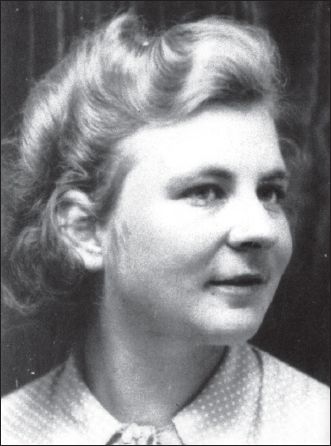The Heart Has Reasons (14 page)


Rut Matthijsen as an elder.
Of course, I’m not saying that the scientists themselves bear no responsibility. In 1941, when the Germans wanted an identification card that would be impossible to counterfeit, the design was actually the work of a Dutch technician named Jacob Lentz. The odd thing is that this fellow was not a Nazi, he was not a member of the NSB—he was simply an overly ambitious civil servant. This was a case where he should have been thinking about the implications of what he was doing, but instead he was trying to rise to a higher position by impressing the Germans. We’ll never know how many lives were lost as a result of his “perfect” ID.
How can we educate our children about the Holocaust?
Children must be taught in stages, because at different ages you need to give them different arguments. And you must do it very carefully, or else it will go awry. Let’s say a teacher shows pictures from the concentration camps to the students in her fifth-grade class in order to teach them about the Holocaust. The children ask, “Who has done that?” The teacher says, “The Germans.” And then, for years afterwards, the children think negatively about Germans. That is not preventing racism: it is propagating it.
I hear teenagers—
three
generations removed from the war—making anti-German remarks. That’s crazy. Germany is the strongest member of the European Union economically, and from a moral point of view they are doing their very best at the moment. So I wonder how these young people, including my own grandchildren, became anti-German. Could it have something to do with well-intentioned adults trying to be sure they will not forget the past?
The same thing can happen when Jewish children are taught the history of anti-Semitism. What good will it do them if they learn to hate Christians and Muslims? You know, before the war, we didn’t give much thought to what religion someone followed. We were all just people, Dutch people. Then the Germans came and made a strict division between Jewish and non-Jewish. Years later, when I went to Israel to receive the Yad Vashem award, I was asked, “Why did you help the Jewish people?” The emphasis being on the word
Jewish
. But that was Adolf Hitler’s emphasis. I helped them because they were people.

When individuals of conscience such as rut matthijsen were impressionable young college students, they surely were influenced by the uniquely defiant atmosphere that existed at Dutch universities during the occupation. The universities were the only institutions other than the churches where one could sometimes find authoritative voices urging people to resist the Nazi injustices. The words and actions of several brave professors still stand today as courageous examples of speaking truth to power.
In the fall of 1940, at the time of the Aryan Attestations, Professor Scholten, a jurist at the University of Amsterdam, circulated a petition that emphasized “the simple fact that there is no Jewish question in the
Netherlands,” and that “it is a matter of indifference whether a scholar is Jewish or not. . . . In the Dutch view, all learning is service to a single, universal truth, involving all mankind, and it is from this service that education derives its moral value and social importance.” The petition was signed by as many as half the faculty at Amsterdam, and, after being circulated at other universities throughout the country, was sent directly to Seyss-Inquart.
Concurrently, the students at Leiden University circulated their own petition, which amassed as many as 2,000 signatures. Dr. Telders, a professor of international law at Leiden, said to his colleagues at that time: “Naturally, it is far easier to let events run their course, but can we really reconcile such passivity with our duty as Dutchmen?” In November 1940, when all Jewish professors at the public universities were dismissed, Professor R. P. Cleveringa, the Dean of the Law School at Leiden, gave a speech on the eve of the departure of one of its Jewish faculty members, the distinguished jurist E. M. Meijers. As Presser reports, Cleveringa did not mince words when talking about the Germans:
Their actions are beneath contempt. All I ask is that we may dismiss them from our sight and gaze instead on the heights, up to that radiant figure in whose honour we are assembled here.
Cleveringa ended his address by expressing the fervent hope that Prof. Meijers, “this noble son of our people, this man, this father to his students, this scholar whom foreign usurpers have suspended from his duties,” would soon return.
As with the public anti-Nazi declarations of the churches, such free speech wasn’t free: Cleveringa was arrested the next day and imprisoned for eight months. Still, thousands of copies of his speech were distributed underground and became part of the rapidly proliferating Resistance literature.
Later in the war, the German authorities began rounding up college students after a vigilante group known as CS-6 fatally wounded a Nazi officer. Before dying, he identified his assailants as students, and the next day the first campus razzia took place. On February 6 1943, 600 students were arrested and sent to Vught concentration camp. Another 1,200 were arrested a few days later.
The Nazis viewed the remaining Dutch students as a source of slave labor, and planned to deport about 7,500 of them to Germany. Things were not going well in Stalingrad, and they needed able bodies
to work in the factories at home so that more Germans could be sent to the Russian front. This led in March ’43 to an Aryan Attestation redux in which all students were required to sign an oath of Nazi loyalty on the threat of being suspended from school and sent to Germany.
The Dutch government in exile called for noncooperation, as did many of the professors. Activist students urged their classmates to refuse to sign and counseled students who were wavering. Despite the additional threat that parents would be held responsible for the decisions of their college-age children, no more than 16 percent signed.
After that, the Germans gave up trying to Nazify the Dutch universities, and more or less shut them down. Students all over the Netherlands hustled to dive under with the help of the LO. The lives of the Utrecht students, however, were in less danger, for a handful of them had previously carried out a raid on the office of university records and burned all the registrar’s files. The raiders—in a rare departure from their usual activities in the Utrecht Kindercomité—were Frits Iordens, Geert Lubberhuizen, Rut Matthijsen, and Anne Maclaine Pont, along with a friend of theirs named Gijs den Besten.
Rut recalls, “We figured the Germans would use the same ‘salami technique’ on the students as they had on the Jews: slice by slice bringing us under their control. So we decided to take preemptive nonviolent action.” Rut was the youngest of the raiders, and it was he who observed that the heavy card stock used to record each student’s name and personal information would not burn easily unless it were well exposed to air. The students spent the night crumpling cards until the pile was higher than their heads, and then set them on fire before exiting the building at 4 a.m. By the time the fire brigade put the blaze out a short time later, the students’ records were smoke and ash.

FOUR
~ GISELA SÖHNLEIN ~
ON WINGS OF SONG

Each of us in this world must cross over
a very narrow bridge. And the most important
thing is not to be at all afraid.
—Reb Nachman
Giesela söhnlein was hetty voûte’s “partner in crime” and companion in the concentration camps, Piglet. After the war, both Hetty and Gisela married men who had also survived the camps, and they settled down in different places to raise families—Hetty in the Dutch East Indies; Gisela in Waalre. The bond between them, however, proved indissoluble. “Hetty was the daredevil,” the now-octogenarian Gisela explained on the phone, “but I caught it from her.”
When we met at her house in Waalre, I found Gisela to be more reserved than Hetty, but just as forthright and hospitable. A small woman with smiling eyes and a hearty laugh, she welcomed me into her home with a warmth I was coming to expect of the rescuers. Her last name means “little son,” which becomes “little sun” as easily in Dutch and German as it does in English. That was her nickname in the Utrecht Kindercomité, and it still fits her today.
Throughout the day, my “ego-meter” registered zero. Though she was happy to answer my questions, and even sing me some of the songs she and Hetty had made up, she seemed entirely content, with no need whatsoever to talk about herself. I found this refreshing, and when I thought back to the self-aggrandizing way people related to each other in the entertainment industry in Los Angeles, it seemed a small miracle. Over the years, we have kept in close touch, and she has helped in many ways with this book.

I grew up in Utrecht,but when the Germans invaded in 1940 I was a student living in a sorority house in Amsterdam with seven other girls. Right across the street was the Gestapo headquarters. In the summer of ’42, they really started going after the Jews, and on July 14 they carried out a big razzia. All that night, I heard trucks pulling up, Germans shouting, dogs barking, and people crying. It was horrible, but there was nothing I could do.
